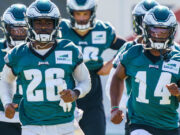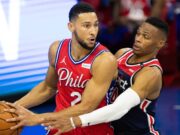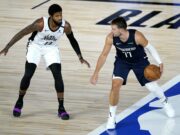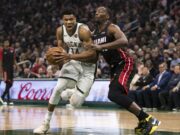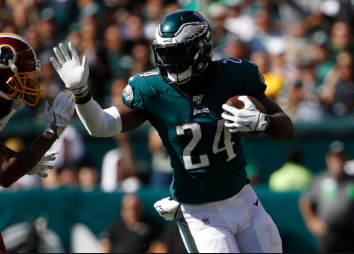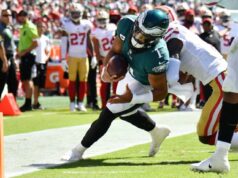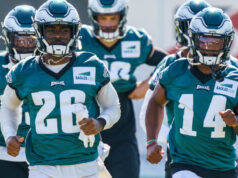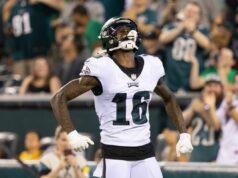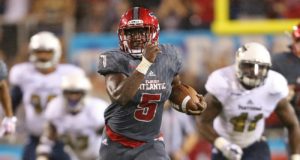In the Week 1 matchup between the Philadelphia Eagles and the Washington Redskins, Jordan Howard averaged a lofty 7.3 yards per carry. His physical, downhill running style was on full display and the Redskins defense was finding it very difficult to stop him. Here’s the catch though: he only carried the ball 6 times the whole game, resulting in 44 yards rushing on the day. Many have questioned why Howard didn’t get the ball more considering he was the team’s most productive runner, and honestly, the concerns are completely understandable. However, I’m here to tell you not to worry. Howard will get more touches. It might not as much as some of you may want, but I’m very confident that his workload will increase.
Explaining why he wasn’t used as much as expected can be a little tricky, especially when it comes to those who are adamant that he’s the best running back on the team. However, if you know Doug Pederson and the system he uses you can find the reasons the rotation ended up the way it did.
Eagles RB snap & touch count from Week 1 against the Redskins…
Miles Sanders: 36 (12 touches)
Darren Sproles: 23 (12 touches)
Jordan Howard: 17 (8 touches)
Corey Clement: 3— Charles “Chux” Maranan (@ChuxMaranan) September 10, 2019
Pederson utilizes a mix of both zone and gap run schemes in his offense, therefore it’s important that the running backs on the roster are capable of running both. The skillset and processing needed when executing zone schemes as opposed to gap schemes is different, and that’s part of the reason why some times run one or the other almost exclusively.
Furthermore, the outside zone play is one of the staples in Pederson’s system. When it comes to outside zone, the ideal type of RB you want is someone with the vision to know when to bounce the run to the outside, bang it straight upfield, or bend it to the cutback lane. No matter what, it’s a one-cut type of run. You also want a RB with the agility and burst to not only make that cut on a dime but also explode into the 2nd level when getting through the hole. If you want an example of this with the Eagles, look back at how effective Jay Ajayi was in this offense in 2017. Pederson and company used him as the lead back because of his ability to execute those outside zone runs so effectively because of his fantastic footwork and explosiveness.
Pederson has also made it known that versatility is also a very important skillset for running backs in this system. Guys can’t just be a good runner and expect to be counted on in this offense. Backs that have the ability to be a legitimate receiving threat and a reliable pass blocker in blitz pickup will always be preferred. That was the issue that arose with LeGarrette Blount in 2017 and why losing Darren Sproles was initially such a big loss (before Corey Clement stepped up in Sproles’ place). Having a one-dimensional runner in the backfield, no matter how talented, does limit the play calling that is at Pederson’s disposal.
The final contributing factor when determining the rotation is the weekly gameplan. If they see a certain matchup that they want to exploit they’re going to lean towards using the RB who is most capable of maximizing that specific matchup. For example, if they’re playing a team with bigger but slower linebackers, they would be more inclined to use a RB who is more dynamic, like Sanders or Sproles. On the flip side, if they’re playing a team with smaller but faster linebackers, then they would be more inclined to use a power runner like Howard.
All of these factors most likely played a big part in why Miles Sanders and Darren Sproles were used so much in Week 1 against the Washington Redskins and Howard wasn’t.
Miles Sanders is the future of the team’s RB position. Actually, he might even be the “right now” guy too. His 36 snaps and 12 total touches, which led all Eagles running backs, show that the coaches already believe in him enough to have him as the lead back in this committee. That’s not to say that he doesn’t have things to work on still, because he absolutely does. He needs to show more patience and lessen his tendency to bounce runs outside so often. And even though he’s made strides in pass protection awareness, he still needs to clean up some of his technique. That being said, the coaches love his dynamic running ability, versatility, and how dangerous he can be in space. That’s why they drafted him in the 2nd round and that’s why the chances of him staying as the lead guy are pretty high.
@ChuxMaranan breaks down @BoobieMilesXXIV debut performance from Week 1. Some good, some bad, and a lot to be excited about. #MilesSanders #FlyEaglesFly #ChuxTapeTakes #Eagles pic.twitter.com/kU1aCTuC1P
— A2D Radio (@a2dradio_com) September 12, 2019
There were a lot of Eagles fans that were upset over Darren Sproles got as many snaps and touches as he did, but they shouldn’t be. He had a great game and the decision to use him as much as they did ended up working, so there’s really nothing to complain about. The coaching staff trusts him, and for good reason. Being the seasoned vet that he is, Sproles rarely makes bad decisions or puts the ball on the ground, and despite being up there in age he’s still an elusive runner who has a knack for making big plays. He’s going to continue to have a role in this offense; there’s no changing that.
With all that being said, you can still give Sanders & Sproles a significant amount of touches while having Howard more involved. It’s not a “one way or another” type of situation. Howard may not be a good receiver, and he may not be a dynamic or explosive athlete, but he is a very good power runner between the tackles. If you want tough yards, he’ll get them for you. You don’t total more than 3,300 rushing yards in 3 seasons without having good talent as a runner. He doesn’t need to be the lead back or get most of the snaps, but there absolutely is a role for him in this offense. He should be in the backfield for any short-yardage or goal-line situations, because that’s what he does best. And when it’s the 4th quarter and the Eagles are trying to protect a big lead and need to run some clock to close out the game, Howard should be the guy. I can’t predict the future and know for certain what the Eagles coaches will do, but I have to believe Howard’s workload will increase. He is too good of a player for that not to happen.
Jordan Howard had a terrific 2nd half as well, making most of what he was given. @JHowardx24 has my vote for more work next week 🙋♂️💪 pic.twitter.com/9Ge3dohGyU
— Thomas R. Petersen 🦅 (@thomasrp93) September 9, 2019
I believe the rotation for this committee will be similar to what we saw back in 2017-18 during the Eagles’ Super Bowl run when they had Jay Ajayi, LeGarrette Blount, and Corey Clement. Sanders will have Ajayi’s role and get around half of the reps as the lead. Howard will have Blount’s role as the power back and main backup to Sanders on the ground. Then Sproles will have Clement’s role being utilized a lot in the passing game for a handful of situations.
No matter how the rotation unfolds as the season goes on, one thing is for sure: this RB Corps is vastly more talented than the one the Eagles finished with last season. We all can argue about how many touches one RB gets compared to another, but it’s a very good problem to have as long as it’s contributing to the team winning week in and week out. Doug’s (or Duce Staley’s, who knows) way of handling the RB rotation over the years has always sparked some debate, but he’s done more than enough to warrant our faith in him that he knows what he’s doing.
The Eagles won a Super Bowl with a committee of Ajayi, Blount, and Clement, so why can’t they win one with a committee of Sanders, Howard, and Sproles using the same formula?




